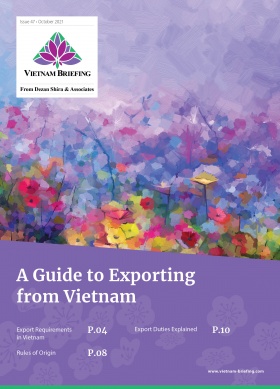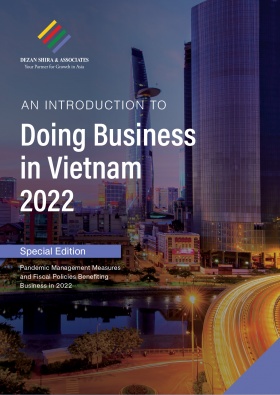Manufacturing in Vietnam: Key Labor Concerns and How to Optimize Your HR Strategy
Vietnam Briefing discusses key labor concerns for businesses in the manufacturing industry, particularly as the country opens up and businesses look to actively recruit labor to meet production targets. With manufacturing taking the lead in FDI investment, we look at how businesses can be competitive using efficient HR strategies.
Stemming from the tensions of the US-China trade war in 2018, several manufacturing businesses have chosen to supplement their China operations by diversifying their production in Vietnam or moving their entire production base to Vietnam.
This trend is likely to continue to accelerate in 2022 due to concerns about dependence on a single manufacturing hub like China which is following a zero COVID approach. On the contrary, Vietnam’s government has chosen to live with the virus, with more than 79 percent of the population fully vaccinated. A combination of these factors continues to make Vietnam an attractive investment destination.
Among the advantages of choosing Vietnam as an investment destination, it would be remiss not to mention Vietnam’s abundant workforce and competitive labor cost. However, the current growing labor demand in manufacturing companies may also raise concerns for businesses interested in setting up their manufacturing hubs in the country.
Labor market post-pandemic
In Q3 2021, Vietnam’s labor market suffered significantly with the number of employed people losing jobs as well as the unemployment and underemployment rates increasing. As per the General Statistics Office (GSO), out of more than 28.2 million people affected by the pandemic, 4.7 million lost their jobs, while 14.7 million people were forced to suspend production and business operations. 12 million had their working hours cut, were laid off, or forced to work on rotational shifts. Another 18.9 million had their incomes reduced.
In particular, due to the strong impact of the pandemic’s fourth wave in 2021, there was a large shift of labor from urban to rural areas and from major economic centers to provinces. According to the Ministry of Labor, Invalids and Social Affairs (MoLISA), about 1.3 million workers left Ho Chi Minh City and key southern provinces for their hometowns due to the pandemic between July and September 2021.
Labor demand is likely to increase further by Q2 2022 when businesses are back to the new normal and operate at their highest capacity. Nike has already stated that their factories in Vietnam are operating at full capacity.
Nevertheless, labor shortages can be expected but not to a serious extent. To actively recruit and keep employees businesses should offer support packages, benefits and ensure a safe work environment.
Ease of recruitment
Typically, it takes companies around one to two months to recruit unskilled labor, while it takes around two to three months for skilled labor. For the manufacturing sector, positions such as accountants, administrative assistants are easier to recruit, but more technical positions such as automation machine operator, CNC operator, mechanical engineering, or quality management are likely to be challenging.
The most effective recruitment channels are participating in job exchanges, associating with HR firms, or working directly with vocational schools. Manufacturing enterprises may consider signing mutual agreements with vocational schools in the area to recruit students for internships and graduates for official positions. Companies can offer scholarships or internship allowances and other welfare schemes such as meals, fuel, or transportation to remain competitive.
Labor turnover
According to Navigos Search, a leading HR firm in Vietnam, there are two times in a year when employees often change jobs:
- At the end of Q1, and at the beginning of Q2 every year, particularly in April-May after employees have received their 13th month salary, KPI bonus, and expect a salary adjustment.
- Low season from June to August, which is the season that companies deliver orders to clients.
New businesses should therefore look to recruit from July to August with jobs commencing in October. Further, from June onwards, students graduate from universities, which makes it a suitable time to recruit young workers who are looking for jobs rather than pursuing further post-secondary education.
Workers change jobs for many reasons such as company management, labor relations, working environment, wages, etc. Therefore, salary and other welfares schemes are key factors for attracting labor.
Several large-scale companies have built conveniences such as on-site sports facilities, daycare, and other entertainment avenues apart from job benefits. Some other companies, in addition to the state’s compulsory insurance, have also offered additional private accident insurance for their employees.
Labor union
Trade unions in Vietnam are allowed but are required to be affiliated to the Vietnam General Confederation of Labor (VGCL), which is linked to the government.
According to Vietnam law, employees have the right to form and join unions (namely Trade Union) and engage in concerted activities for their collective protection. The Trade Union is not required to be established by law, however, enterprises with more than 10 employees are encouraged to form a union, especially those engaged in production activities.
Employees, through their union representatives, may negotiate with their employers and participate in bargaining agreements concerning the terms and conditions of their employment and legal proceeding related to cases of labor, administration, enterprise bankruptcy in order to protect the legal and legitimate rights and interests of labor collective and laborers. Under certain circumstances, employees also have the right to conduct a strike in accordance with the law.
In practice, unions are hardly able to exercise their power as written in law. At enterprises, union representatives are also employees of the company, hired by the company and elected by the collective of employees but under the recommendation/designation of the company’s board of directors.
Normally the head of the union shall be either the chief financial officer, the human resources manager, or even the general manager. Therefore, unions can only protect the interests of workers to a certain extent. Trade unions can be considered as a bridge between employees and the company’s board of directors, helping to convey employees’ thoughts and aspirations to leaders.
About Us
Vietnam Briefing is produced by Dezan Shira & Associates. The firm assists foreign investors throughout Asia from offices across the world, including in Hanoi, Ho Chi Minh City, and Da Nang. Readers may write to vietnam@dezshira.com for more support on doing business in Vietnam.
We also maintain offices or have alliance partners assisting foreign investors in Indonesia, India, Singapore, The Philippines, Malaysia, Thailand, Italy, Germany, and the United States, in addition to practices in Bangladesh and Russia.
- Previous Article Vietnam’s Pharmaceuticals Industry: A Comprehensive Guide for 2022
- Next Article How the Russia-Ukraine Conflict is Affecting Businesses in Vietnam






























